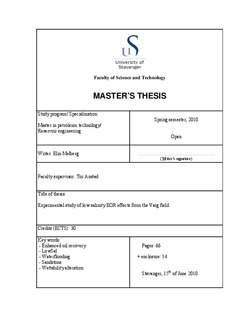| dc.description.abstract | The extra oil recovery obtained when flooding a sandstone reservoir with low saline water is called low salinity (LowSal) effect. The term salinity refers to amount (and type) of salt that makes up the ionic composition of the brine. The injected water must have a different composition and a lower salinity than the initial formation water to promote significant desorption of oil from the rock surface. Several different hypotheses have been proposed as low salinity mechanisms. Fines migration, pH increase and multicomponent ionic exchange (MIE) are among the best known. But none of these hypotheses have so far been generally accepted as the main mechanism. It is assumed that LowSal effect is due to a wettability modification towards more water-wet conditions. Desorption of oil components in a low salinity environment makes the rock more water-wet. There is also a considerable amount of data which shows that oil recovery can be dependent on polar components in the crude oil, divalent cations in the formation water, like Ca2+ and Mg2+, and active clays in the sandstone.
The Varg field in the Norwegian part of the North Sea is at late life production, but low saline waterflooding may increase the lifetime of the field. In this study, two different sandstone reservoir cores from Varg, Varg#5 and Varg#6, were flooded with sea water/low saline water in order to observe LowSal effect. The initial water saturation of the cores was established using a desiccator. The cores were saturated with crude oil, containing CO2, from the Varg reservoir. They were aged for 14 days at reservoir temperature, 130 °C. During the main flooding test, both cores were flooded with high saline Varg formation brine (201 560 ppm) in a secondary stage, sea water (33 390 ppm) in a tertiary stage and finally a 500 ppm NaCl-solution as LowSal fluid. The displacement temperature was 130 °C. The oil recovery by secondary displacement with formation brine was 43% and 27% of the original oil in place (OOIP) for Varg#5 and Varg#6 respectively. No extra oil was recovered by sea water and low saline NaCl-solution. The main reason for no observations of LowSal effect may be the high ageing temperature and increase in relative adsorption of organic material and active cations onto the clay surface. | en_US |
